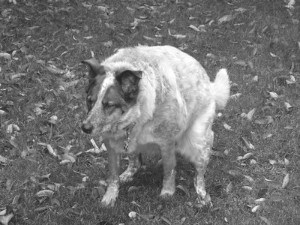
As a pet parent, canine diarrhea is always a cause for concern as it’s a sign that something isn’t right. Dog diarrhea is a fairly common problem because it’s usually one of the first symptoms of many dog diseases including intestinal parasites.
Intestinal parasites such as roundworms, hookworms, whipworms, tapeworms can all infect dogs and severe infections can be life-threatening especially in puppies and weak dogs.
Dogs with worms can also transmit them to their humans, therefore, it’s important to understand how dogs get worms and recognize the signs of worms in pets for timely treatment, as this affects the entire family.
[1] Can worms in dogs cause diarrhea?
Yes, canine diarrhea can be a result of intestinal parasites. In some cases, animals with worms may not show any obvious signs but when they do, diarrhea can be one of the telling signs. And depending on the severity of the infection, dogs can have bloody diarrhea or stool with mucus.
Blood in stool and prolonged diarrhea can lead to lethargy, dehydration, vomiting, change in appetite, high blood pressure, and in the case of a chronic heartworm infection can result in heart failure. Intestinal parasites in dogs can be a life-threatening disease, especially prolonged infection in pups or malnourished dogs, and if left untreated can cause death.
Not all dogs with worms will show any visible signs of infection, sometimes the worm larvae will lay dormant in a dog’s system for a long time without the animal getting sick. But will eventually manifest during periods of extreme stress for the dog. If you notice that your dog’s stool has a tinge of blood or mucus, you should see a vet as quickly as possible.
[2] What are the other symptoms or side effects of worms?
Canine worms require immediate medical attention, and a severe infestation can be deadly. But how can you tell if your dog has intestinal parasites, besides diarrhea, here are other symptoms of worms in dogs;
Coughing and vomiting: these are common symptoms of worm infestation in dogs. Heartworms will cause dry and persistent coughs, because they infect the lungs and affect the respiratory system. Coughing can also be a sign of hookworms and roundworms, dogs with these worms may also vomit visible worms. And whipworm infection can cause dogs to vomit a yellowish green substance.
Weight loss: weight loss can be due to poor diet or an underlying health issue, but it can also be a sign of intestinal worms stealing nutrients from the dog’s intestines. Tapeworms and whipworms can cause rapid weight loss in dogs.
Bloated belly: this is a common sign of roundworm infestation in puppies, but it’s sometimes seen in adult dogs. Puppies can get infected with roundworms from their mother, either while still growing in the mother’s body or during the nursing stage from breast milk.
Dry and dull coat: loss of fur, dry and dull coat with visible rashes is also a sign of parasitic infections like worms. A perfectly healthy dog should have a thick and shiny coat.
Lethargy: worms absorb nutrients from digested dog food leaving the dog with less than enough, oftentimes this causes serious lack of energy and lethargy in dogs.
Worms in faeces: severe worm infestation may result in visible worms in dog stool. Worms like roundworms and tapeworms may be present in a dog’s stool as tiny moving rice-like specks. You may also find tiny grain-like particles in the dog’s sleeping area or around their rear.
Scratching or rubbing their rear: worms can cause itchiness around the rear and to help relieve this discomfort, you may notice your dog licking his butt or scratching and rubbing their butt of the floor or against furniture.
[3] How do dogs get worms?
Dogs get worms in different ways, most times it can by nipping or eating contaminated soil containing microscopic worm eggs, eating infected meat or through their skin especially their feet. Here are the various ways dogs can get worms.
From their mothers: if a pregnant dog is infected with roundworms or hookworms, she can pass it down to her puppies through the placenta and if this happens, the young pups are born infected with worms. Or she can pass it to the puppies during the nursing stage when they feed on breast milk from the mother.
By ingesting infected stool or soil: when dogs ingest soil or faecal matter containing microscopic larvae or eggs of intestinal worms, they travel through the dogs’ digestive tract where they will continue their development to become adult parasites feeding off the dog.
By ingesting contaminated meat: some dogs enjoy hunting small prey like rodents and birds, and sometimes they tend to eat their kill. Worms can be transmitted to dogs when they eat infected meat, especially raw meat.
From external parasites: some external parasites like fleas act as hosts to certain intestinal parasites like tapeworms. If a dog eats an infected flea, the tapeworms in the flea are passed into the dog’s system and the unfortunate dog becomes their new host.
Through skin contact: when dogs walk on infected soil or stool, some worms like hookworms can attach themselves to dogs’ paws and burrow into their skin to infect them.
[4] Why do worms cause diarrhea?
Once a dog is infested with worms, these parasites will travel through the dog’s body and settle in the intestines, this is especially true for roundworms, hookworms, tapeworms and whipworms. These intestinal parasites establish themselves in the intestines of their host where they feed on the food of their host.
Whipworms live around the area where the large and small intestines meet, and they feed on their victim’s blood, roundworms live in the intestines and feed on partially digested food. Tapeworms use their hook-like mouth parts to attach themselves to the walls of the small intestines where they feed on digested food, and hookworms also attach themselves to the lining of the intestinal walls where they extract nutrients to nourish themselves.
When these parasites extract nutrients from digested food, they cause diarrhea and other symptoms like bloody stool, lethargy, vomiting, etc. Sometimes these worms are present in an infected dog’s stool and a vet can see them during microscopic examination of stool samples.
[5] What are the other causes of diarrhea?
Diarrhea may be a sign of intestinal parasites in pets, but this isn’t always the case as dogs with normal bowel movements and solid stool may still have worms buried deep within their bodies. Diarrhea is caused by unusually fast bowel movement which is accompanied by improper absorption of water, electrolytes and nutrients from digested food.
It is a fairly common problem in dogs and can be a sign of many dog illnesses such as bacterial or viral infections, organ dysfunction, intestinal worms, stress, gastrointestinal inflammation due to food allergies or dietary indiscretion, and a host of other reasons.
The colour and consistency of a dog’s stool also gives a clue to the underlying cause of dog diarrhea. Normal dog poop should be chocolate brown and solid, soft or poor-quality stool can be a sign that something isn’t right.
For instance, bloody stool can be a sign of intestinal worms, black stool may be due to internal bleeding, orange stool may be due to problems with the liver, green stool or one with red streaks may signify a gallbladder issue, greasy or grey stool can mean a possible problem with the pancreas, etc.
[6] How to cure diarrhea in dogs?
If your dog has diarrhea with other symptoms like vomiting and lethargy, take your dog to the nearest vet clinic and don’t try to administer any home treatments yourself. But if your dog only has diarrhea and signs of vomiting or any other symptoms, then you can try the conventional treatment of withholding food for a period of 12 to 24 hours or giving small amounts of food and water. Frequent water intake is very important for a dog with diarrhea as it prevents dehydration.
Other ways to help a dog with diarrhea;
- Prepare a bland diet with only easily digestible ingredients such as white rice, wholemeal pasta, porridge oats or potatoes with plain boiled chicken or fish. No spice, fat or diary.
- Each meal portion should be small, it’s important to feed your dog frequent small meals like 4 to 6 small portions in a day, and monitor the stool quality.
- If the diarrhea clears after a few days, continue with the bland diet for a few more days (2 to 3 days) and try to gradually increase the portion sizes. But if symptoms persist, see a vet as quickly as you can.
Closing Thoughts
Canine diarrhea can be due to a number of dog diseases, but it can also be a symptom of intestinal worms, especially when accompanied by other symptoms like blood in stool, lethargy, weight loss, pot-bellied appearance, dull coat, coughing, vomiting, and moving rice-like specks in stool. Dogs mostly get worms by accidentally ingesting infected substances or from their mother as puppies. If your dog has diarrhea and any of the other symptoms above, the best course of action is an emergency visit to the vet.






